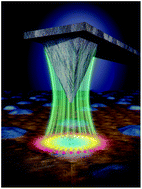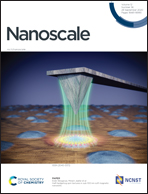Half-hedgehog spin textures in sub-100 nm soft magnetic nanodots†
Abstract
Topologically non-trivial structures such as magnetic skyrmions are nanometric spin textures of outstanding potential for spintronic applications due to their unique features. It is well known that Néel skyrmions of definite chirality are stabilized by the Dzyaloshinskii–Moriya exchange interaction (DMI) in bulk non-centrosymmetric materials or ultrathin films with strong spin–orbit coupling at the interface. In this work, we show that soft magnetic (permalloy) hemispherical nanodots are able to host three-dimensional chiral structures (half-hedgehog spin textures) with non-zero tropological charge. They are observed at room temperature, in absence of DMI interaction and they can be further stabilized by the magnetic field arising from the Magnetic Force Microscopy probe. Micromagnetic simulations corroborate the experimental data. Our work implies the existence of a new degree of freedom to create and manipulate complex 3D spin-textures in soft magnetic nanodots and opens up future possibilities to explore their magnetization dynamics.



 Please wait while we load your content...
Please wait while we load your content...